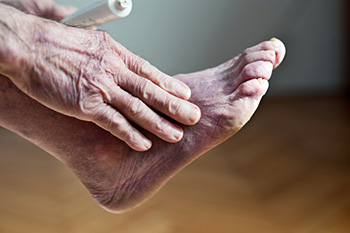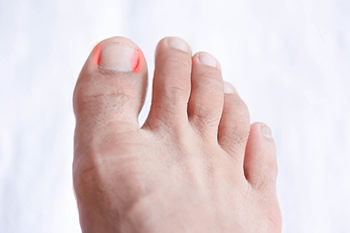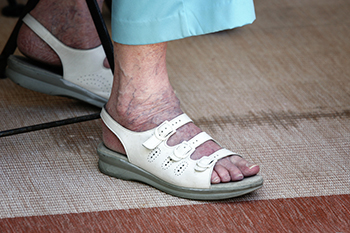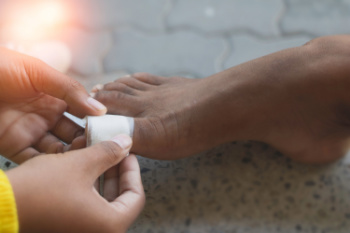Connect With Us
Blog
Items filtered by date: May 2024
Improving Poor Circulation in the Feet

Circulation refers to the movement of blood throughout the body, delivering oxygen and nutrients to tissues while removing waste products. Poor circulation in the feet can lead to various problems and is often caused by conditions such as peripheral artery disease, diabetes, obesity, and prolonged inactivity. Smoking and a sedentary lifestyle also contribute to reduced blood flow. Symptoms of poor circulation in the feet include numbness, tingling, cold feet, swelling, cramping, and skin discoloration. If left untreated, these issues can lead to more severe complications like ulcers, infections, and, in extreme cases, gangrene. Improving circulation involves lifestyle changes such as regular exercise, maintaining a healthy weight, quitting smoking, and eating a balanced diet rich in fruits, vegetables, and whole grains. Wearing compression stockings and elevating the feet can also help. If you have trouble with poor circulation in your feet, it is suggested that you consult a podiatrist for personalized advice and effective treatment options.
Poor circulation is a serious condition and needs immediate medical attention. If you have any concerns with poor circulation in your feet contact Michael Schwartzman, DPM of Illinois and Indiana . Our doctor will treat your foot and ankle needs.
Poor Circulation in the Feet
Poor blood circulation in the feet and legs is can be caused by peripheral artery disease (PAD), which is the result of a buildup of plaque in the arteries.
Plaque buildup or atherosclerosis results from excess calcium and cholesterol in the bloodstream. This can restrict the amount of blood which can flow through the arteries. Poor blood circulation in the feet and legs are sometimes caused by inflammation in the blood vessels, known as vasculitis.
Causes
Lack of oxygen and oxygen from poor blood circulation restricts muscle growth and development. It can also cause:
- Muscle pain, stiffness, or weakness
- Numbness or cramping in the legs
- Skin discoloration
- Slower nail & hair growth
- Erectile dysfunction
Those who have diabetes or smoke are at greatest risk for poor circulation, as are those who are over 50. If you have poor circulation in the feet and legs it may be caused by PAD and is important to make changes to your lifestyle in order to reduce risk of getting a heart attack or stroke. Exercise and maintaining a healthy lifestyle will dramatically improve conditions.
As always, see a podiatrist as he or she will assist in finding a regimen that suits you. A podiatrist can also prescribe you any needed medication.
If you have any questions please feel free to contact our offices located in West Chicago, IL and Whiting, IN . We offer the newest diagnostic and treatment technologies for all your foot and ankle needs.
Arthritis Can Cause Pain in the Feet and Ankles
How to Know if You Have an Ingrown Toenail

Recognizing an ingrown toenail early is important for timely treatment and prevention of complications. This condition occurs when the edge of a toenail grows into the surrounding skin, leading to inflammation, pain, and potential infection. Common causes of an ingrown toenail include improper nail trimming, wearing tight footwear, or genetic predisposition. Symptoms of an ingrown toenail can consist of redness, swelling, and tenderness along the nail border. In severe cases, pus or drainage may occur. Diagnosis typically involves a physical examination by a podiatrist. Treatment options include remedies like warm soaks and gentle nail trimming. A podiatrist also may offer treatment such as lifting the nail edge or surgical removal. If you have an ingrown toenail, it is suggested that you schedule an appointment with a podiatrist to prevent symptoms from worsening and obtain correct treatment.
Ingrown toenails may initially present themselves as a minor discomfort, but they may progress into an infection in the skin without proper treatment. For more information about ingrown toenails, contact Michael Schwartzman, DPM of Illinois and Indiana . Our doctor can provide the care you need to keep you pain-free and on your feet.
Ingrown Toenails
Ingrown toenails are caused when the corner or side of a toenail grows into the soft flesh surrounding it. They often result in redness, swelling, pain, and in some cases, infection. This condition typically affects the big toe and may recur if it is not treated properly.
Causes
- Improper toenail trimming
- Genetics
- Improper shoe fitting
- Injury from pedicures or nail picking
- Abnormal gait
- Poor hygiene
You are more likely to develop an ingrown toenail if you are obese, have diabetes, arthritis, or have any fungal infection in your nails. Additionally, people who have foot or toe deformities are at a higher risk of developing an ingrown toenail.
Symptoms
Some symptoms of ingrown toenails are redness, swelling, and pain. In rare cases, there may be a yellowish drainage coming from the nail.
Treatment
Ignoring an ingrown toenail can have serious complications. Infections of the nail border can progress to a deeper soft-tissue infection, which can then turn into a bone infection. You should always speak with your podiatrist if you suspect you have an ingrown toenail, especially if you have diabetes or poor circulation.
If you have any questions, please feel free to contact our offices located in West Chicago, IL and Whiting, IN . We offer the newest diagnostic and treatment technologies for all your foot care needs.
How Aging Can Affect Your Feet

As people age, their feet bear the brunt of a lifetime of activity, an accumulation of wear and tear that can lead to various problems. Women over 50 are particularly prone to foot issues as they age. These are caused by hormonal changes, decreased bone density, and the effects of wearing high heels. The soft tissues in the feet lose elasticity over time, making older adults more susceptible to conditions like Achilles tendonitis and plantar fasciitis. Among the foot problems associated with aging are stress fractures, plantar fasciitis, and bunions, flat feet, and osteoarthritis, which can hinder mobility and cause discomfort, are other ailments common among seniors. While simple measures like wearing supportive shoes and engaging in low-impact exercises can alleviate symptoms, persistent foot pain necessitates professional attention from a podiatrist, or a foot and ankle specialist, to prevent further complications. If you are an older adult who is experiencing foot or ankle pain, it is suggested that you make an appointment with a podiatrist for an exam and treatment.
Proper foot care is something many older adults forget to consider. If you have any concerns about your feet and ankles, contact Michael Schwartzman, DPM from Illinois and Indiana . Our doctor can provide the care you need to keep you pain-free and on your feet.
The Elderly and Their Feet
As we age we start to notice many changes in our body, but the elder population may not notice them right away. Medical conditions may prevent the elderly to take notice of their foot health right away. Poor vision is a lead contributor to not taking action for the elderly.
Common Conditions
- Neuropathy – can reduce feeling in the feet and can hide many life-threatening medical conditions.
- Reduced flexibility – prevents the ability of proper toenail trimming, and foot cleaning. If left untreated, it may lead to further medical issues.
- Foot sores – amongst the older population can be serious before they are discovered. Some of the problematic conditions they may face are:
- Gouging toenails affecting nearby toe
- Shoes that don’t fit properly
- Pressure sores
- Loss of circulation in legs & feet
- Edema & swelling of feet and ankles
Susceptible Infections
Diabetes and poor circulation can cause general loss of sensitivity over the years, turning a simple cut into a serious issue.
If you have any questions please feel free to contact our offices located in West Chicago, IL and Whiting, IN . We offer the newest diagnostic and treatment technologies for all your foot and ankle needs.
Treating Blisters on the Feet
 Blisters on the feet commonly develop due to friction and pressure. This can occur when wearing new or ill-fitting shoes, or from intense activities like running or hiking. Blisters are small pockets of fluid that form under the skin to cushion and protect deeper tissues from damage. While blisters often heal on their own, improper care can lead to infection and further complications. A podiatrist can help manage blisters on the feet, both by treating existing blisters and helping with prevention techniques. They can safely drain large or painful blisters in a sterile environment, apply appropriate dressings, and prescribe topical treatments to prevent infection. Additionally, podiatrists can provide valuable advice on selecting the right footwear and using special padding or insoles to reduce friction points. Podiatrists may also recommend specific socks or taping techniques to protect sensitive areas of the feet, which can prevent future blisters and ensure healthy foot care practices. If you have painful or recurrent blisters on the feet, it is suggested that you make an appointment with a podiatrist.
Blisters on the feet commonly develop due to friction and pressure. This can occur when wearing new or ill-fitting shoes, or from intense activities like running or hiking. Blisters are small pockets of fluid that form under the skin to cushion and protect deeper tissues from damage. While blisters often heal on their own, improper care can lead to infection and further complications. A podiatrist can help manage blisters on the feet, both by treating existing blisters and helping with prevention techniques. They can safely drain large or painful blisters in a sterile environment, apply appropriate dressings, and prescribe topical treatments to prevent infection. Additionally, podiatrists can provide valuable advice on selecting the right footwear and using special padding or insoles to reduce friction points. Podiatrists may also recommend specific socks or taping techniques to protect sensitive areas of the feet, which can prevent future blisters and ensure healthy foot care practices. If you have painful or recurrent blisters on the feet, it is suggested that you make an appointment with a podiatrist.
Blisters are prone to making everyday activities extremely uncomfortable. If your feet are hurting, contact Michael Schwartzman, DPM of Illinois and Indiana . Our doctor can provide the care you need to keep you pain-free and on your feet.
Foot Blisters
Foot blisters develop as a result of constantly wearing tight or ill-fitting footwear. This happens due to the constant rubbing from the shoe, which can often lead to pain.
What Are Foot Blisters?
A foot blister is a small fluid-filled pocket that forms on the upper-most layer of the skin. Blisters are filled with clear fluid and can lead to blood drainage or pus if the area becomes infected.
How Do Blisters Form?
Blisters on the feet are often the result of constant friction of skin and material, usually by shoe rubbing. Walking in sandals, boots, or shoes that don’t fit properly for long periods of time can result in a blister. Having consistent foot moisture and humidity can easily lead to blister formation.
Prevention & Treatment
It is important to properly care for the affected area in order to prevent infection and ease the pain. Do not lance the blister and use a Band-Aid to provide pain relief. Also, be sure to keep your feet dry and wear proper fitting shoes. If you see blood or pus in a blister, seek assistance from a podiatrist.
If you have any questions, please feel free to contact our offices located in West Chicago, IL and Whiting, IN . We offer the newest diagnostic and treatment technologies for all your foot care needs.

